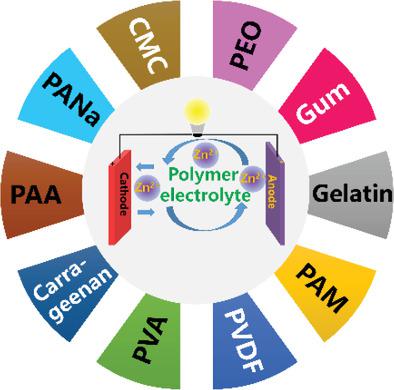当前位置:
X-MOL 学术
›
Adv. Energy Mater.
›
论文详情
Our official English website, www.x-mol.net, welcomes your
feedback! (Note: you will need to create a separate account there.)
Recent Advances in Polymer Electrolytes for Zinc Ion Batteries: Mechanisms, Properties, and Perspectives
Advanced Energy Materials ( IF 24.4 ) Pub Date : 2020-02-12 , DOI: 10.1002/aenm.201903977 Kai Wu 1 , Jianhang Huang 2 , Jin Yi 1 , Xiaoyu Liu 1 , Yuyu Liu 1 , Yonggang Wang 2 , Jiujun Zhang 1 , Yongyao Xia 2, 3
Advanced Energy Materials ( IF 24.4 ) Pub Date : 2020-02-12 , DOI: 10.1002/aenm.201903977 Kai Wu 1 , Jianhang Huang 2 , Jin Yi 1 , Xiaoyu Liu 1 , Yuyu Liu 1 , Yonggang Wang 2 , Jiujun Zhang 1 , Yongyao Xia 2, 3
Affiliation

|
Aqueous rechargeable zinc ion batteries (ZIBs) have been deemed to be possible candidates for large‐scale energy storage due to their ecoefficiency, substantial reserve, safety, and low cost. However, the challenges inherent in aqueous electrolytes, such as water splitting reactions, water evaporation, and liquid leakage, have greatly hindered their development in energy storage. Fortunately, polymer electrolytes would be able to overcome the abovementioned challenges. Moreover, the flexible properties of polymer electrolytes can facilitate their future application in wearable electronics. Recently, increasing attention has been attracted to the polymer electrolyte‐based zinc ion batteries. However, the development of polymer electrolytes for ZIBs is still in the early stages due to numerous challenges. Therefore, substantial research effort is required to overcome the challenges of polymer electrolyte‐based ZIBs. In this review, the current progress in developing polymer electrolytes, including solid polymer electrolytes, gel polymer electrolytes, and hybrid polymer electrolytes, as well as the interactions between electrodes and polymer electrolytes for ZIBs is comprehensively reviewed, analyzed, and discussed in terms of their synthesis, characterization, and performance validation. To facilitate further research and development of polymer electrolytes for ZIBs, the relevant challenges are summarized and analyzed, and some underlying approaches to overcome these challenges are also proposed.
中文翻译:

锌离子电池聚合物电解质的最新进展:机理,性能和前景
水性可充电锌离子电池(ZIBs)由于其生态效率高,储备量大,安全且成本低廉,因此被认为是大规模储能的候选方案。然而,水性电解质固有的挑战,例如水分解反应,水蒸发和液体泄漏,极大地阻碍了它们在能量存储中的发展。幸运的是,聚合物电解质将能够克服上述挑战。此外,聚合物电解质的柔韧性可以促进它们在可穿戴电子产品中的未来应用。近来,基于聚合物电解质的锌离子电池引起了越来越多的关注。然而,由于众多挑战,用于ZIB的聚合物电解质的开发仍处于早期阶段。因此,需要大量的研究工作来克服基于聚合物电解质的ZIB的挑战。在这篇综述中,对ZIBs聚合物电解质(包括固体聚合物电解质,凝胶聚合物电解质和杂化聚合物电解质)的开发进展以及电极与聚合物电解质之间的相互作用进行了全面的综述,分析和讨论,综合,表征和性能验证。为了促进用于ZIBs的聚合物电解质的进一步研究和开发,总结并分析了相关挑战,并提出了一些克服这些挑战的基本方法。包括ZIBs的固体聚合物电解质,凝胶聚合物电解质和混合聚合物电解质,以及电极与聚合物电解质之间的相互作用,都从其合成,表征和性能验证的角度进行了全面的综述,分析和讨论。为了促进ZIBs聚合物电解质的进一步研究和开发,总结并分析了相关挑战,并提出了一些克服这些挑战的潜在方法。包括ZIBs的固体聚合物电解质,凝胶聚合物电解质和杂化聚合物电解质,以及电极与聚合物电解质之间的相互作用,都从其合成,表征和性能验证的角度进行了全面的综述,分析和讨论。为了促进ZIBs聚合物电解质的进一步研究和开发,总结并分析了相关挑战,并提出了一些克服这些挑战的潜在方法。
更新日期:2020-03-27
中文翻译:

锌离子电池聚合物电解质的最新进展:机理,性能和前景
水性可充电锌离子电池(ZIBs)由于其生态效率高,储备量大,安全且成本低廉,因此被认为是大规模储能的候选方案。然而,水性电解质固有的挑战,例如水分解反应,水蒸发和液体泄漏,极大地阻碍了它们在能量存储中的发展。幸运的是,聚合物电解质将能够克服上述挑战。此外,聚合物电解质的柔韧性可以促进它们在可穿戴电子产品中的未来应用。近来,基于聚合物电解质的锌离子电池引起了越来越多的关注。然而,由于众多挑战,用于ZIB的聚合物电解质的开发仍处于早期阶段。因此,需要大量的研究工作来克服基于聚合物电解质的ZIB的挑战。在这篇综述中,对ZIBs聚合物电解质(包括固体聚合物电解质,凝胶聚合物电解质和杂化聚合物电解质)的开发进展以及电极与聚合物电解质之间的相互作用进行了全面的综述,分析和讨论,综合,表征和性能验证。为了促进用于ZIBs的聚合物电解质的进一步研究和开发,总结并分析了相关挑战,并提出了一些克服这些挑战的基本方法。包括ZIBs的固体聚合物电解质,凝胶聚合物电解质和混合聚合物电解质,以及电极与聚合物电解质之间的相互作用,都从其合成,表征和性能验证的角度进行了全面的综述,分析和讨论。为了促进ZIBs聚合物电解质的进一步研究和开发,总结并分析了相关挑战,并提出了一些克服这些挑战的潜在方法。包括ZIBs的固体聚合物电解质,凝胶聚合物电解质和杂化聚合物电解质,以及电极与聚合物电解质之间的相互作用,都从其合成,表征和性能验证的角度进行了全面的综述,分析和讨论。为了促进ZIBs聚合物电解质的进一步研究和开发,总结并分析了相关挑战,并提出了一些克服这些挑战的潜在方法。











































 京公网安备 11010802027423号
京公网安备 11010802027423号